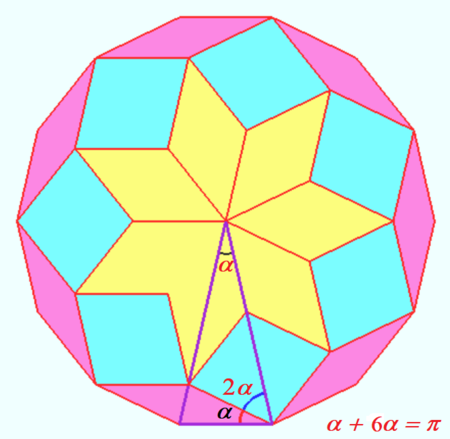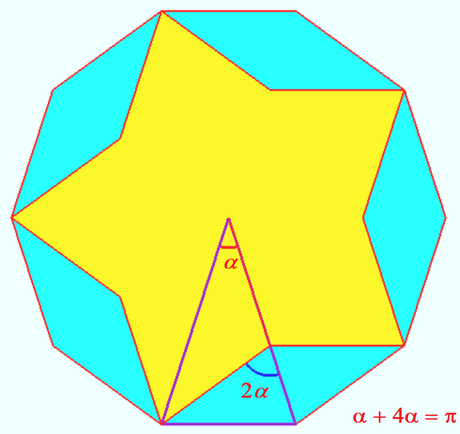Difference between revisions of "2020 AIME I Problems/Problem 1"
(→187) |
(→Solution 2) |
||
| (13 intermediate revisions by 7 users not shown) | |||
| Line 1: | Line 1: | ||
== Problem == | == Problem == | ||
| − | In <math>\triangle ABC</math> with <math>AB=AC,</math> point <math>D</math> lies strictly between <math>A</math> and <math>C</math> on side <math>\overline{AC},</math> and point <math>E</math> lies strictly between <math>A</math> and <math>B</math> on side <math>\overline{AB}</math> such that <math>AE=ED=DB=BC.</math> The degree measure of <math>\angle ABC</math> is <math>\tfrac{m}{n},</math> where <math>m</math> and <math>n</math> are relatively prime positive integers. Find <math>m+n.</math> | + | In <math>\triangle ABC</math> with <math>AB=AC,</math> point <math>D</math> lies strictly between <math>A</math> and <math>C</math> on side <math>\overline{AC},</math> and point <math>E</math> lies strictly between <math>A</math> and <math>B</math> on side <math>\overline{AB}</math> such that <math>AE=ED=DB=BC.</math> The degree measure of <math>\angle ABC</math> is <math>\tfrac{m}{n},</math> where <math>m</math> and <math>n</math> are relatively prime positive integers. Find <math>m+n.</math> |
== Solution 1== | == Solution 1== | ||
| Line 38: | Line 38: | ||
This tells us <math>\angle{BCA}=\angle{ABC}=3x</math> and <math>3x+3x+x=180</math>. | This tells us <math>\angle{BCA}=\angle{ABC}=3x</math> and <math>3x+3x+x=180</math>. | ||
Thus <math>x=\frac{180}{7}</math> and we want <math>\angle{ABC}=3x=\frac{540}{7}</math> to get an answer of <math>\boxed{547}</math>. | Thus <math>x=\frac{180}{7}</math> and we want <math>\angle{ABC}=3x=\frac{540}{7}</math> to get an answer of <math>\boxed{547}</math>. | ||
| − | ==Solution 3 (Official MAA)== | + | ==Solution 3 (Official MAA)== |
Let <math>x = \angle ABC = \angle ACB</math>. Because <math>\triangle BCD</math> is isosceles, <math>\angle CBD = 180^\circ - 2x</math>. Then | Let <math>x = \angle ABC = \angle ACB</math>. Because <math>\triangle BCD</math> is isosceles, <math>\angle CBD = 180^\circ - 2x</math>. Then | ||
<cmath>\angle DBE = x - \angle CBD = x - (180^\circ - 2x) = 3x - 180^\circ\!.</cmath>Because <math>\triangle EDA</math> and <math>\triangle DBE</math> are also isosceles, | <cmath>\angle DBE = x - \angle CBD = x - (180^\circ - 2x) = 3x - 180^\circ\!.</cmath>Because <math>\triangle EDA</math> and <math>\triangle DBE</math> are also isosceles, | ||
| Line 74: | Line 74: | ||
https://youtu.be/4XkA0DwuqYk | https://youtu.be/4XkA0DwuqYk | ||
| + | |||
| + | ==Solution 4 (writing equations)== | ||
| + | graph soon | ||
| + | |||
| + | We write equations based on the triangle sum of angles theorem. There are angles that do not need variables as the less variables the better. | ||
| + | |||
| + | <cmath>\begin{align*} | ||
| + | \angle A &= y \ | ||
| + | \angle B &= x+z \ | ||
| + | \angle C &= \frac{180-x}{2} \ | ||
| + | \end{align*}</cmath> | ||
| + | |||
| + | Then, using triangle sum of angles theorem, we find that | ||
| + | |||
| + | <cmath>\begin{align*} | ||
| + | \angle A + \angle B + \angle C = x+y+z+\frac{180-x}{2}=180 \ | ||
| + | \end{align*}</cmath> | ||
| + | |||
| + | Now we just need to find the variables. | ||
| + | |||
| + | <cmath>\begin{align*} | ||
| + | (180-2y)+z = 180& \ | ||
| + | (180-2z)+y+\frac{180-x}{2} = 180& \ | ||
| + | \end{align*}</cmath> | ||
| + | |||
| + | Notice how all the equations equal 180. We can use this to write | ||
| + | |||
| + | <cmath>\begin{align*} | ||
| + | (180-2y)+z = (180-2z)+y+\frac{180-x}{2}=x+y+z+\frac{180-x}{2} \ | ||
| + | \end{align*}</cmath> | ||
| + | |||
| + | Simplifying, we get | ||
| + | |||
| + | <cmath>\begin{align*} | ||
| + | (180-2y)+z=(180-2z)+y+\frac{180-x}{2} \ | ||
| + | 360-4y+2z=360-4z+2y+180-x \ | ||
| + | \end{align*}</cmath> | ||
| + | |||
| + | <cmath>\begin{align*} | ||
| + | 6z=6y+180-x \ | ||
| + | x=6y-6z+180 \ | ||
| + | \end{align*}</cmath> | ||
| + | |||
| + | <cmath>\begin{align*} | ||
| + | (180-2y)+z=6y-6z+180+y+z+\frac{180-(6y-6+180)}{2} \ | ||
| + | 360-4y+2z=12y-12z+360+2y+2z+180-6y+6z-180 \ | ||
| + | \end{align*}</cmath> | ||
| + | |||
| + | <cmath>\begin{align*} | ||
| + | 6z=12y& \ | ||
| + | z=2y& \ | ||
| + | \end{align*}</cmath> | ||
| + | |||
| + | Theres more. We are at a dead end right now because we forgot that the problem states that the triangle is isosceles. With this, we can write the equation | ||
| + | |||
| + | <cmath>\begin{align*} | ||
| + | \frac{180-x}{2}=x+z \ | ||
| + | \end{align*}</cmath> | ||
| + | |||
| + | Substituting <math>z</math> with <math>2y</math>, we get | ||
| + | |||
| + | <cmath>\begin{align*} | ||
| + | \frac{180-x}{2}=x+2y \ | ||
| + | 180-x=2x+4y \ | ||
| + | \end{align*}</cmath> | ||
| + | <cmath>\begin{align*} | ||
| + | 180-(6y-6z+180)=2(6y-6z+180)+4y& \ | ||
| + | 180-6y+12y-180=12y-24y+360+4y& \ | ||
| + | \end{align*}</cmath> | ||
| + | <cmath>\begin{align*} | ||
| + | 6y=-8y+360& \ | ||
| + | \end{align*}</cmath> | ||
| + | |||
| + | With this, we get | ||
| + | |||
| + | <cmath>\begin{align*} | ||
| + | y=\frac{180}{7} \ | ||
| + | x=\frac{180}{7} \ | ||
| + | z=\frac{360}{7} \ | ||
| + | \end{align*}</cmath> | ||
| + | |||
| + | And a final answer of <math>\frac{180}{7}+\frac{360}{7} = \frac{540}{7} = \boxed{547}</math>. | ||
| + | |||
| + | ~[[OrenSH|orenbad]] | ||
| + | |||
| + | == Video Solution by OmegaLearn == | ||
| + | https://youtu.be/O_o_-yjGrOU?t=333 | ||
| + | |||
| + | ~ pi_is_3.14 | ||
==Video solution== | ==Video solution== | ||
| Line 80: | Line 169: | ||
https://youtu.be/mgRNqSDCvgM ~yofro | https://youtu.be/mgRNqSDCvgM ~yofro | ||
| + | |||
| + | ==Solution without words== | ||
| + | [[File:2020 AIME I 1.png|450px|left]] | ||
| + | [[File:2020 AIME I 1a.png|460px|right]] | ||
| + | '''vladimir.shelomovskii@gmail.com, vvsss''' | ||
==See Also== | ==See Also== | ||
Revision as of 15:01, 24 January 2024
Contents
[hide]Problem
In ![]() with
with ![]() point
point ![]() lies strictly between
lies strictly between ![]() and
and ![]() on side
on side ![]() and point
and point ![]() lies strictly between
lies strictly between ![]() and
and ![]() on side
on side ![]() such that
such that ![]() The degree measure of
The degree measure of ![]() is
is ![]() where
where ![]() and
and ![]() are relatively prime positive integers. Find
are relatively prime positive integers. Find ![]()
Solution 1
![[asy] size(10cm); pair A, B, C, D, F; A = (0, tan(3 * pi / 7)); B = (1, 0); C = (-1, 0); F = rotate(90/7, A) * (A - (0, 2)); D = rotate(900/7, F) * A; draw(A -- B -- C -- cycle); draw(F -- D); draw(D -- B); label("$A$", A, N); label("$B$", B, E); label("$C$", C, W); label("$D$", D, W); label("$E$", F, E); [/asy]](http://latex.artofproblemsolving.com/e/9/e/e9e27ce12b66c38e61f3aeeeec6ac0760eebc7e9.png)
If we set ![]() to
to ![]() , we can find all other angles through these two properties:
1. Angles in a triangle sum to
, we can find all other angles through these two properties:
1. Angles in a triangle sum to ![]() .
2. The base angles of an isosceles triangle are congruent.
.
2. The base angles of an isosceles triangle are congruent.
Now we angle chase. ![]() ,
, ![]() ,
, ![]() ,
, ![]() ,
, ![]() ,
, ![]() . Since
. Since ![]() as given by the problem,
as given by the problem, ![]() , so
, so ![]() . Therefore,
. Therefore, ![]() , and our desired angle is
, and our desired angle is ![]() for an answer of
for an answer of ![]() .
.
See here for a video solution: https://youtu.be/4e8Hk04Ax_E
Solution 2
Let ![]() be
be ![]() in degrees.
in degrees. ![]() .
By Exterior Angle Theorem on triangle
.
By Exterior Angle Theorem on triangle ![]() ,
, ![]() .
By Exterior Angle Theorem on triangle
.
By Exterior Angle Theorem on triangle ![]() ,
, ![]() .
This tells us
.
This tells us ![]() and
and ![]() .
Thus
.
Thus ![]() and we want
and we want ![]() to get an answer of
to get an answer of ![]() .
.
Solution 3 (Official MAA)
Let ![]() . Because
. Because ![]() is isosceles,
is isosceles, ![]() . Then
. Then
![]() Because
Because ![]() and
and ![]() are also isosceles,
are also isosceles,
![]()
![]() Because
Because ![]() is isosceles,
is isosceles, ![]() is also
is also ![]() , so
, so ![]() , and it follows that
, and it follows that
![]() . The requested sum is
. The requested sum is ![]() .
.
![[asy] unitsize(4 cm); pair A, B, C, D, E; real a = 180/7; A = (0,0); B = dir(180 - a/2); C = dir(180 + a/2); D = extension(B, B + dir(270 + a), A, C); E = extension(D, D + dir(90 - 2*a), A, B); draw(A--B--C--cycle); draw(B--D--E); label("$A$", A, dir(0)); label("$B$", B, NW); label("$C$", C, SW); label("$D$", D, S); label("$E$", E, N); [/asy]](http://latex.artofproblemsolving.com/8/0/0/800a1b87e83f02303a544a1cc3b37b3a774d9483.png)
https://artofproblemsolving.com/wiki/index.php/1961_AHSME_Problems/Problem_25 (Almost Mirrored)
See here for a video solution:
Solution 4 (writing equations)
graph soon
We write equations based on the triangle sum of angles theorem. There are angles that do not need variables as the less variables the better.

Then, using triangle sum of angles theorem, we find that
![]()
Now we just need to find the variables.

Notice how all the equations equal 180. We can use this to write
![]()
Simplifying, we get

![]()

![]()
Theres more. We are at a dead end right now because we forgot that the problem states that the triangle is isosceles. With this, we can write the equation
![]()
Substituting ![]() with
with ![]() , we get
, we get

![]()
![]()
With this, we get

And a final answer of ![]() .
.
Video Solution by OmegaLearn
https://youtu.be/O_o_-yjGrOU?t=333
~ pi_is_3.14
Video solution
https://youtu.be/mgRNqSDCvgM ~yofro
Solution without words
vladimir.shelomovskii@gmail.com, vvsss
See Also
| 2020 AIME I (Problems • Answer Key • Resources) | ||
| Preceded by First Problem |
Followed by Problem 2 | |
| 1 • 2 • 3 • 4 • 5 • 6 • 7 • 8 • 9 • 10 • 11 • 12 • 13 • 14 • 15 | ||
| All AIME Problems and Solutions | ||
The problems on this page are copyrighted by the Mathematical Association of America's American Mathematics Competitions. ![]()











